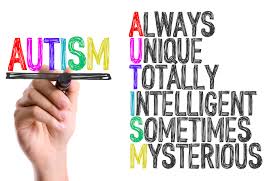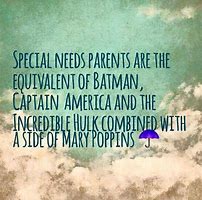Under… “What to do While You Wait”
INTRODUCTION:
Knowing your child and knowing your child’s Autism.
Knowing the difference may help you move forward.
Loving your children... keeping them safe...
& finding out how they learn is part of what parenting is all about!
Each child learns differently & each parent 'parents' differently.
This website hopefully becomes a continuing source of information for you.
When a child has difficulty learning about themselves & their world...
or, developing slowly it isn't always AUTISM.
And, if it is AUTISM... know that it's NO ONE'S fault.
The exact cause of AUTISM is yet unknown.
What is known is that it is a NEUROLOGICAL difference in the child's brain.
This difference is possibly caused by an interaction of genes & environment.
The child's development pattern can begin to look different from other children their same age.
This difference can be from mild to severe. From the passive 'quiet' child to the 'wild' child.
Along with knowing your child, you will begin to know yourself.
Getting help is the key. Early intervention works!
Programs, therapies and interventions are costly and can have both positive and negative effects. That’s why it is so important to ‘know your child’ and ‘know your child’s autism’ can be so critical. When treatments are successful, everything changes. Positive-negative side effects for young children can be that they become much more aware of what they want and how to get it. Then, when you don’t understand what they want, they get upset and tantrum or pinch to get your attention.
When a child becomes more ‘aware’ and begins to have a heightened understanding of how things around them work; for instance doors and windows. And where the neighborhood candy store is, then successful ‘escape’ behaviors may start to occur. After years of building his skills and confidence, Ken Siri’s (2014) autistic son Alex ran off in downtown Manhattan. He was finally found after two frantic hours of searching. He had made it out of the house, through traffic, to his favorite candy store. Smiles.
Siri & Lyons (2014) say that as researchers begin to understand enough about each individual’s autism, they can develop a particular treatment for that particular dysfunction. When doctors can do a ‘biochemical’ profile they can start to understand the child’s symptoms. There is talk about how allergies can cause a ‘cascade’ of events which may look like a behavior. The presence of chronic gastrointestinal (GI) symptoms in children with ASD can cause diseases of the intestinal track.
This demands medical attention, evaluation, and changes which may include treating diet, nutrition. When treated, unwanted behaviors may disappear. Also, some say that understanding how various environmental toxins can cause stress or upset hormone levels in the thyroid, in a child with autism, is necessary to improve overall health.
In 2015 Alice Park, Senior Science journalist for TIME Magazine, published an interesting article titled – Researchers Zero In on the Best Way to Diagnose Autism. She tells us that traditionally, autism is diagnosed with behavioral tests that assess whether kids are meeting developmental milestones, such as talking, interacting with their parents and siblings, and learning to give and take in social situations. But that in recent years, scientists have been working on other ways to detect and potentially diagnose autism, such as having identified more than 100 genes connected with a higher risk of developing autism.
- Limits of my ability to provide my child’s intervention myself, after training? (Would you want to try?)
- Limit of my child’s ability to tolerate certain interventions? (How long can my child engage without problems?)
- Limit of the professionals we have easy access to? (Who’s out there and how can they help me?)
- Limit of our city, county, or state to provide help? (Should I look in other places for what we need?)
- Limit of our family financial and personal resources? (Should I consult a financial advisor?)
- Limit of our child’s ‘label’ once they are diagnosed? (Is the ‘label’ broad enough to get the services we need?)
- Limit of our insurance company coverage? (Have I all the information I need about providers, referrals & coverage?)
- Limit of our status as may be needed to receive outside help? (How does our Zip Code affect services? Too rich or too poor…)
Chess & Thomas (1995) tell us that most children and adults master the trials of daily living while others fail to meet the same demands at home, at school, with peers and at work. So, professionals are trying to understand why we have such behavioral differences. And to determine interventions that will eliminate, or at least reduce, problems in functioning.
Recently, there has been renewed interest in understanding a children's temperament to help us treat a range of behavior and conduct problems. They believe that temperament predictability can even help to prevent the onset of certain undesirable behaviors.
These physicians have found that several factors combine with temperament to shape personality throughout childhood and adult life. They are:
- Cognition – Does s/he understand the purpose of what’s going on around them?
- Self-awareness – Does s/he understand that there is a world outside themselves?
- Motivation – What are the child’s motivators? (Probably the things s/he fixates, focuses, or perseverates on.)
They go on to say that the interaction between clinicians, teachers, and others in your child’s learning environment need to be a ‘good fit’ in order for everyone to become successful. Here are some examples they cite – If your daughter has a low stimulation threshold and you aren’t aware that she’s irritated by wearing scratchy clothing.
This may exaggerate her natural temperament. Or, if your son doesn’t warm up to strangers, try allowing a meeting in a more comfortable setting. For instance, in a place he likes to go. By recognizing and respecting individual temperaments you can avoid unnecessary conflict and unwanted behaviors. It helps to play detective.
< My Thoughts > “…a place he likes to go.”
A place our Sonny likes to go is Mc Donald’s. Meeting someone new at Mickey D’s while munching on fries and washing it down with soda… that’s a win-win situation for Sonny. Then when he sees that ‘person’ again, at least the meeting is off to a pretty good start.
Bottom line, you want to keep your child in a setting where there is reduced anxiety and frustration. Plus, this is an opportunity for bonding with the new ‘person’ and a chance for your child to have a learning experience where s/he will gain some feeling of satisfaction and accomplishment.
Meanwhile, children with Autism communicate in one of the few ways available to them – through temper tantrums, hyperactivity and /or aggressive behaviors towards self and others. Through behavior modification plans and programs, parents and teachers strive to control the chaos in their lives (Sicile-Kira, 2004).
For behavior intervention to be successful in older children, it must be a collaborative effort between the home and school. Parents may have difficulty buying into a behavior intervention because as Thompson (2007) tells us, first the family has to truly believe that their child had Autism and that they are not going to snap out of it or outgrow it.
Another difficulty for the family may be the unfamiliar terms and concepts they will encounter. Parents may also have difficulty creating the changes necessary due to the daily routines and demands of their own lives. An alternative strategy would be to begin with the family’s day-to-day routines.
< My Thoughts > “Parents may have difficulty buying into a behavior intervention.”
Know what you can and can’t do. Know your child’s strengths and willingness to accept these changes. You will find that there is hope and there is help, as we continue to explore ways to ‘know your child’. Next, we will discuss ‘temperament’ and what to look for in your child and yourself, too. Smiles.
References:
Chess, S. & Thomas, A. (1995). Keep your child's temperament in mind when analyzing problems and solutions; Brown University Child & Adolescent Behavior Letter, 10581073, Jun95, Vol. 11, Issue 6.
Sicile-Kira, C. (2004). Autism Spectrum Disorders: The Complete Guide to Understand Autism, Asperger’s Syndrome, Pervasive Developmental Disorder, and other ASD’s. New York: Perigee/The Berkeley Publishing Group.
Siri, K. (2010). 1,001Tips for the Parents of Autistic Boys; Skyhorse Publishing, New York, N.Y.
Siri, K. & Lyons, T. (2014). Cutting-Edge Therapies for Autism; 4th Edition; Skyhorse Publishing, New York, N.Y.
Thompson, T. (2007). Making Sense of Autism. Baltimore, Maryland. Paul H. Brookes Publishing Co.
========


 RSS Feed
RSS Feed